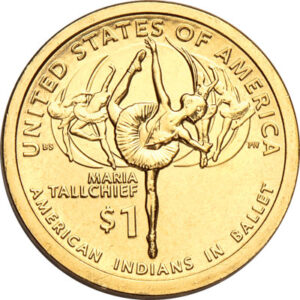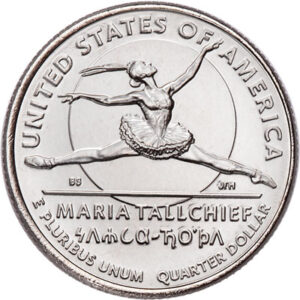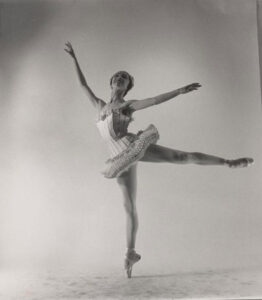As Visions of Sugar Plums Danced

Few women have had their images struck on legal tender U.S. coins. To date, none are honored twice – on different denominations – in the same year except for one! Native American Maria Tallchief of the Osage Nation.
Surprised? So was I!
Earlier this year, I introduced you to the Five Moons featured on the 2023 Native American dollar. Maria fronts that group of dancers that includes her sister. Now, come with me and meet America’s first prima ballerina honored on the last 2023 U.S. Women Quarter.
Remaining True to Her Roots
The Five Moons were Native American ballet dancers with tribal roots from several reservations in Oklahoma. Maria was the breakaway international star. Her father was Alexander Tall Chief; her mother, Ruth Porter, of Scottish-Irish heritage. Maria stood a statuesque 5’9” tall, with a long neck, torso and graceful arms. She also possessed tremendous athletic stamina and musicality.
“From your first plié you are learning to become an artist. In every sense of the word, you are poetry in motion,” Maria wrote in her 1997 memoir. “And if you are fortunate enough…you are actually the music.”
At 17, she entered the professional ballet world in New York City. The year was 1942. She signed with the Ballet Russe de Monte Carlo. Earning $50 a week, she started touring. Ballet management suggested she take the stage name “Tolchieva” to give the impression that she was Russian. She refused.
According to the Library of Congress, Maria Tallchief remained closely identified with her Native American heritage. In 1953, the Osage Nation gave her the title “Princess Wa-Txthe-thonba” meaning “the Woman of Two Standards” in recognition of her ability to move effortlessly between cultures. That title appears in Osage orthography as wa-txthe-thonba on the reverse of her quarter.
First a Firebird then 2 Swans…
But before that tribal honor was bestowed, Maria had left the Ballet Russe. As his muse, she joined contemporary choreographer George Balanchine’s nascent ballet company in New York. In 1946 she married the Russian émigré. A year later she became the first American ballet dancer to perform with the famed Paris Opera Ballet. And the following year, 1948, Balanchine’s New York City Ballet (NYCB) with Maria Tallchief in a starring role, took its formal bow in Manhattan; in October of 2023, the company officially commemorated its 75th anniversary.

In 1949, Balanchine unveiled a new production for “Firebird.” His choreography closely interpreted the lush orchestration of modernist composer Igor Stravinsky written for a 1910 ballet of the same name. It was based on a Russian folk tale about a mythical red bird who joins forces with a prince to defeat an evil sorcerer. In the starring role was the gifted 24-year-old ballerina from Oklahoma, eager to perform a new dance composition.
Observed Lincoln Kirstein, Balanchine’s NYCB business partner, “Maria Tallchief made an electrifying appearance, emerging as the nearest approximation to a prima ballerina that we had yet enjoyed.”
Maria’s next notable performance came in Balanchine’s technically demanding choreography for his remake of “Swan Lake.” Based on another Russian folk tale, the lead dancer traditionally performs the dual roles: Odette is the innocent princess cursed by an evil sorcerer to live as a swan by day, assuming human form only at night; Odile is the sorcerer’s evil daughter sent to trick a prince attempting to break the spell.
Balanchine’s new choreography fit like a glove to the symphonic score composed by Pyotr Tchaikovsky for the original 1877 production. Years later, in a 1994 interview, Maria shared that “Tchaikovsky is perhaps the greatest dance music of all…he certainly knew what dancers liked, and it’s always great satisfaction to dance [to his.]”
…and finally, the Sugar Plum Fairy!
In 1892, Tchaikovsky had composed a score and Marius Petipa choreography for a lavish ballet set during a Christmas Eve party. Its inspiration came from the 1845 story adapted by French writer, Alexander Dumas. His lighter version came, in fact, from an 1816 dark tale written by Prussian author and music critic E.T.A. Hoffman, “The Nutcracker and the Mouse King.”
It’s the story of a young girl, Clara, who falls asleep during the holiday party and dreams of a nutcracker-turned-prince successfully battling a Mouse King. The new balletic work debuted December 18th in St. Petersburg. Over 40 years later, a copy of the choreography notebook was smuggled out of Russia to England. In 1934, the ballet was performed in the west for the first time.
Ballet insiders give the nod to Tchaikovsky’s score as opening the door for a choreographer to insert a solo in the ballet’s fourth dream sequence called Land of the Sweets that included candy canes from Russia. Balanchine had just the dancer in mind when he wrote a new composition for the two-act ballet, even though the couple had divorced by then. In 1954, when the dancer who would still be his muse was 29, “The Nutcracker” debut in New York to wild acclaim.
Public Figures Who Appear Twice on U.S. Currency

Wrote dance critic Walter Terry, “Maria Tallchief, as the Sugar Plum Fairy, is herself a creature of magic, dancing the seemingly impossible with effortless beauty of movement, electrifying us with her brilliance, enchanting us with her radiance of being. Does she have any equals anywhere, inside or outside of fairyland? While watching her in ‘The Nutcracker,’ one is tempted to doubt it.”
Moreover, Maria’s tour-de-force solo elevated the Russian folk tale from obscurity into a holiday classic performed annually by ballet troupes large and small, regional and international. Before Maria retired from dancing in 1966, Balanchine would choreograph 32 ballets that showcased her talent. After she left the stage, Maria went to serve as artistic director of the Chicago Lyric Opera Ballet and the founder and artistic director of the Chicago City Ballet. In 1966, she was inducted into the National Women’s Hall of Fame; in 1999, she received the National Medal for the Arts, and posthumously she was inducted into the National Native American Hall of Fame in 2018.
Other public figures from U.S. history who appear twice – on both circulating coins and paper currency – include George Washington (quarter and one-dollar bill), Abraham Lincoln (cent and five-dollar bill), Thomas Jefferson (nickel and two-dollar bill), and Benjamin Franklin (now-obsolete half dollar and 100 dollar bill).
SOURCES:
Duffie, Bruce. “Conversation Piece: Prima Ballerina Maria Tallchief.” Accessed August 25, 2023. http://www.bruceduffie.com/tallchief2.html
Library of Congress Blogs. “Maria Tallchief: Osage Prima Ballerina.” Accessed August 23, 2023. https://blogs.loc.gov/headlinesandheroes/2019/11/maria-tallchief-osage-prima-ballerina/
Tallchief, Maria with Larry Kaplan. Maria Tallchief: America’s Prima Ballerina. New York: Henry Holt and Company, 1997.
“Tchaikovsky’s Nutcracker: A beginner’s guide.” Accessed August 25, 2023. https://www.classicfm.com/composers/tchaikovsky/pictures/beginners-guide-tchaikovskys-nutcracker/




Who would believe this much was written about your subject? It should bring many orders. The Nutcracker is one of my favorites.
Carolyn Grass
Ms Tallchief was an impressive woman! Thanks for visiting.
Fascinating information, beautifully written – thank you for this article.
You’re quite welcome! Thank you for the kind words & for stopping by. Happy holidays!